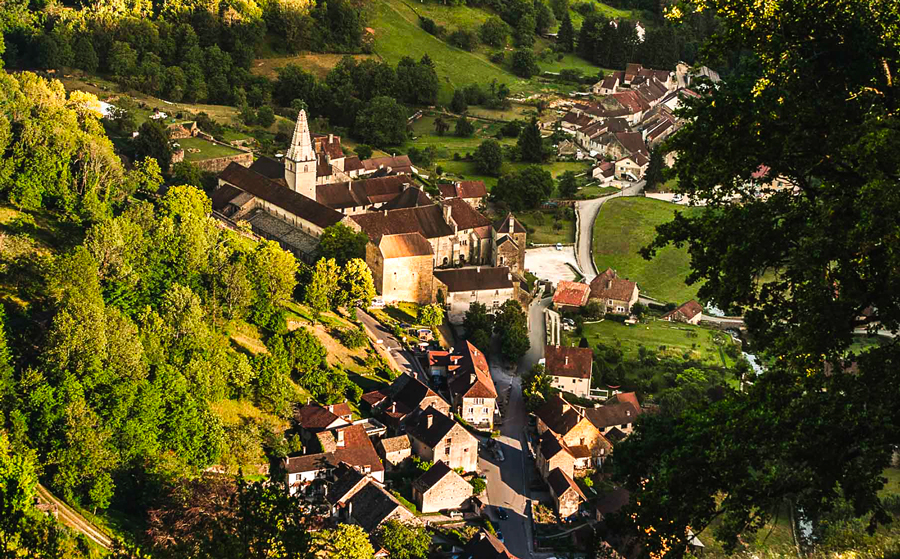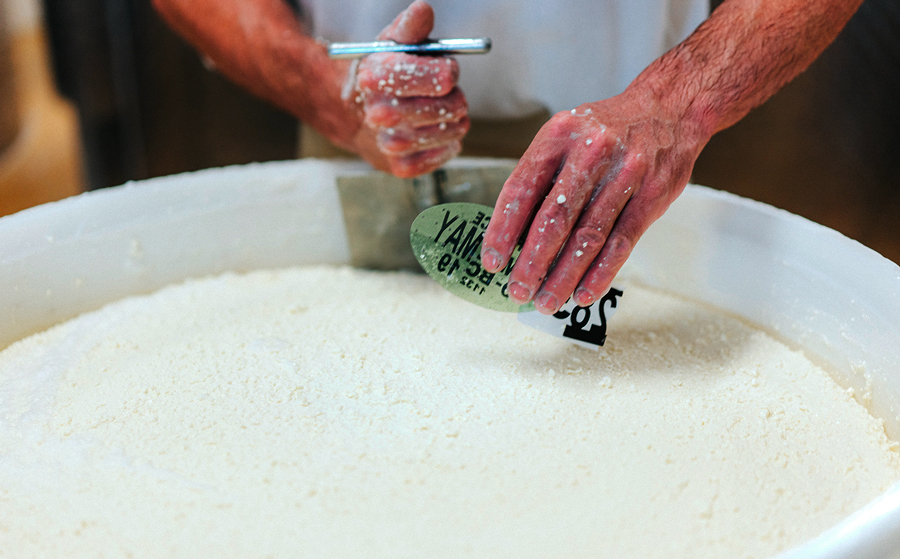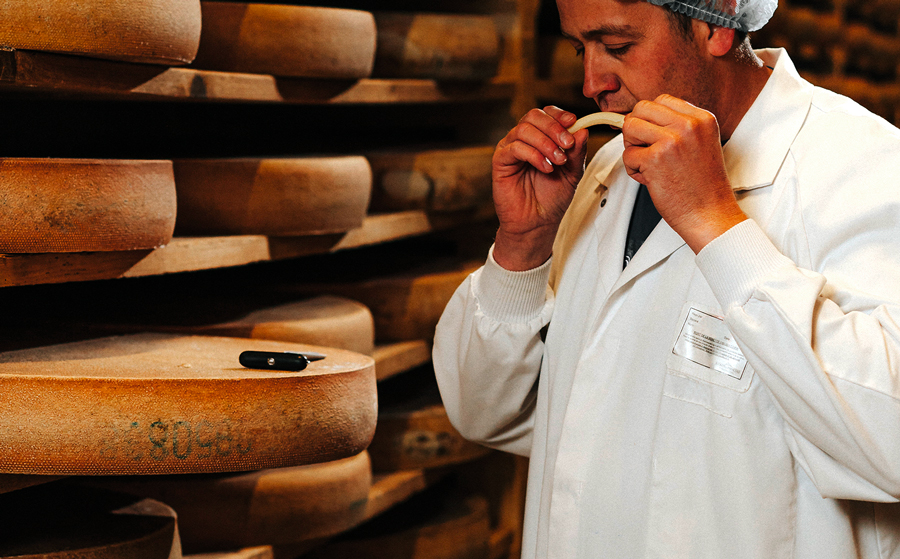

Comté is more than just a cheese—it is a testament to centuries of craftsmanship, a harmony between nature and humanity, and a celebration of the Jura region’s unique identity.
The Journey of Production
A Medieval Invention
Comté’s origins date back to the Middle Ages when farmers in the Jura mountains sought a solution for long winters. By pooling their milk and resources, they created large wheels of cheese that could be aged for months or even years, ensuring sustenance for their families during harsh seasons. This cooperative system gave rise to the fruitières, or cheese-making cooperatives, where the collective effort remains at the heart of Comté production.
Protected Origins
The PDO (Protected Denomination of Origin) zone for Comté spans three departments within the Jura Massif: the Doubs, the Jura, and a portion of Ain. Situated at altitudes between 200 and 1,500 meters, this region is a tapestry of lush pastures and diverse flora. Comté earned its AOC (Appellation d’Origine Contrôlée) status in 1958, protecting its French heritage, and its PDO designation in 1996, granting it European recognition.

From Milk to Wheel
The production of Comté begins with raw milk from Montbéliarde and French Simmental cows exclusively. These cows are integral to the cheese’s quality and must have ample space to graze. To maintain the Comté PDO designation, each cow requires a minimum pasture area equivalent to the surface of the Flower Dome in Marina Bay Garden. For context, the Botanic Gardens in Singapore could only accommodate 60 cows under these strict standards.
The process includes:

- Milk maturing : The Comté cheese-making process begins by inoculating the milk with yeasts specific to each “fruitière”. These lactic ferments act as acidifiers during pressing. They contribute to the development of the cheese’s taste qualities. At a temperature of 32°C, specific ferments are added to acidify the milk and it will help prepare the milk for the next step. This ripening process takes 45 minutes, and the milk is stirred continuously.
- Curdling: After 45 minutes of maturing, the addition of rennet activates the coagulation of the milk (30-35 minutes)
- Cutting and Cooking: A change of tools takes place: the brewers are replaced by equipment called “curd slicers”. Once the curds have reached the desired consistency, the cheesemaker cuts them into rice-grain-sized pieces. The whole is then heated from 53°C minimum gently to 55°C and stirred continuously to exude the whey. It will give the texture of the cheese.
- Moulding and Pressing: The curds are pressed into molds, creating iconic wheels weighing 32-45 kg. Pressing takes a minimum of 6 hours, and the cheeses are removed from the mould the following morning.
- Brining/Salting : The wheels are immersed in a saltwater solution to enhance flavor and preservation. First salted, the cheeses are rubbed with morge. This brine, sown with sourdoughs, contributes to the formation of the Comté cheese’s rind and enriches its aromatic identity.
- Pre-refining phase : it lasts 21 days, during which the cheese wheels are kept in a very humid atmosphere at a constant temperature of 12°C.
- Final ripening : wheels are carried out successively in warm cellars (14-19°C). Placed on spruce boards, the Comté cheeses mature under the watchful eye of the cellar master. They are regularly turned over and rubbed with morge on the surface.
The minimum total maturing period for Comté is 4 months. This is often extended to 18 or 24 months, or even longer, to ensure optimal development of its organoleptic qualities.
The color of Comté’s paste reflects the seasons—golden yellow in spring and summer, thanks to beta-carotene from fresh grass, and paler in winter when the cows are fed hay.
The Art of Grading
Not all wheels of Comté are created equal. At four months, each wheel undergoes a rigorous grading process by a team of experts called “gradeurs”. Using their senses of sight, touch, smell, and even sound (knocking on the wheel), they score the cheese on a scale of 20. A green label indicates a score of 14 or higher, signifying top-tier quality, while a brown label is given to those scoring between 12 and 14. Wheels scoring below 12 lose the Comté designation altogether.
The Art of Aromas

Comté’s complexity lies in its remarkable range of flavors, developed during its aging process, or affinage. This art is carried out in humid caves, where the wheels rest on spruce boards and are regularly brushed and turned.
- Lactic Aromas: Found in younger Comté (4-6 months), these include notes of butter, cream, and white chocolate.
- Fruity Aromas: Emerging in mid-aged Comté (6-12 months), with hints of citrus, dried fruit, and flowers.
- Vegetal Aromas: Featuring green, herbal notes like fresh grass and hay.
- Roasted Aromas: Present in aged Comté (12+ months), with bold flavors like toasted bread, coffee, and chocolate.
The longer a wheel is aged, the more its texture changes—from supple to crumbly—and its flavors intensify. Those tiny white crystals you may find in aged Comté? They’re not salt but tyrosine, an amino acid formed during aging that adds a delightful crunch and umami richness.
Comté in the Kitchen
Comté’s versatility makes it a favourite ingredient for both traditional and modern dishes. At M&T Bistro, it takes centre stage in our Signature Cordon Bleu, our Croque Monsieur or Croissant Comte.
Comté’s ability to pair beautifully with a wide variety of accompaniments makes it a staple on cheese boards as well. For an unforgettable tasting experience, try it with fig chutney, acacia honey, or fresh pineapple, paired with a glass of Jura’s white wine, a black tea or a floral sake.
A Cheese to Remember
Every wheel of Comté carries a piece of the Jura’s history and a story of collaboration, craftsmanship, and care. Whether enjoyed on its own, paired with fine wine, or incorporated into a gourmet dish, Comté invites you to savor its rich flavors and timeless tradition.




